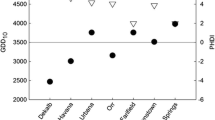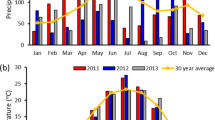Abstract
Alfalfa (Medicago sativa L.) is a promising bioenergy and bioproduct feedstock because of its high yield, N-fixation capacity, potential for planting in rotation with corn (Zea mays L.), and valuable protein co-product (leaf meal). Our objective was to examine the effect of growth environment on biomass yield, cellulosic ethanol traits, and paper pulp fiber characteristics of alfalfa stems. Landscape position (summit and mild slope), season of harvest (four harvests per season), and multiple years (2005 and 2006) provided environmental variation. Alfalfa stem samples were analyzed for cell wall carbohydrate and lignin concentration. Stems were subjected to dilute acid pre-treatment, enzymatic saccharification, and pulping processes to measure relevant cellulosic ethanol and paper production traits. Landscape position was not a significant source of variation for yield or any biomass quality trait. Yields varied among harvests in 2005 (1,410–3,265 kg ha−1) and 2006 (1,610–3,795 kg ha−1). All cell wall, conversion test, and paper production traits exhibited year by harvest interactions with no clear pattern. Total carbohydrates and lignin ranged from 440 to 531 g kg−1 DM and from 113 to 161 g kg-1 DM, respectively. Release of cell wall sugars by the conversion test ranged widely (419 to 962 g kg−1 DM). Fiber traits were similarly variable with length and fine content ranging from 1.24 to 1.59 mm and from 15.2% to 21.9%, respectively. Utilizing alfalfa biomass for cellulosic ethanol and paper pulp production will involve dealing with significant feedstock quality variation due to growth environment.





Similar content being viewed by others
References
Adner B, Baker J (1996) Measurement of cellulase activities; LAP-006. NREL Analytical Procedure. National Renewable Energy Laboratory, Golden
Afyuni MM, Cassel DK, Robarge WP (1993) Effect of landscape position on soil water and corn silage yield. Soil Sci Soc Am J 57:1573–1580
Ahmed AER, Labavitch JM (1977) A simplified method for accurate determination of cell wall uronide content. J Food Biochem 1:361–365
Almeida JRM, Modig T, Petersson A, Hahn-Hagerdal B, Liden G, Gorwa-Grausland MF (2007) Increased tolerance and conversion of inhibitors in lignocellulosic hydrolysates by Saccharomyces cerevisiae. J Chem Technol Biotechnol 82:340–349
Barnes DK, Bingham ET, Marphy RP et al (1977) Alfalfa germplasm in the United States: genetic vulnerability, use, improvement and maintenance. USDA Technical Bulletin 1571, Washington, pp. 1–21
Boateng AA, Jung HG, Adler PR (2006) Pyrolysis of energy crops including alfalfa stems, reed canarygrass and eastern gamagrass. Fuel 85:2450–2457
Buxton DR, Casler MD (1993) Environmental and genetic effects on cell wall composition and digestibility. In: Jung HG, Buxton DR, Hatfield RD, Ralph J (eds) Forage cell wall structure and digestibility. ASA-CSA-SSSA, Madison, pp 685–714
Buxton DR, Hornstein JS, Wedin WF, Marten GC (1985) Forage quality in stratified canopies of alfalfa, birdsfoot trefoil, and red clover. Crop Sci 25:273–279
Buxton DR, Russell JR, Wedin WF (1987) Structural neutral sugars in legume and grass stems in relation to digestibility. Crop Sci 27:11279–1285
Carter PR, Sheaffer CC (1983) Alfalfa response to soil water deficits. I. Growth, forage quality, yield water use, and water-use efficiency. Crop Sci 23:669–675
Casey JP (1980) Pulp and paper chemistry and chemical technology vol II, 3rd edn. Wiley-Interscience, New York, p 827
Chernoglazov VM, Ermolova OV, Klyosov AA (1988) Adsorption of high-purity endo-1, 4-beta-glucanases from Trichoderma reesei on components of lignocellulosic materials—cellulose, lignin and xylan. Enzyme Microb Technol 10:503–507
Dale BE (1983) Biomass refining: protein and ethanol from alfalfa. Ind Eng Chem Prod Res Dev 22:466–472
Deetz DA, Jung HG, Buxton DR (1994) Water deficit effects on cell wall composition and in-vitro degradability of structural polysaccharides from alfalfa stems. Crop Sci 36:383–388
DeLong MM, Swanberg DR, Oelke EA et al (1995) Sustainable biomass energy production and rural economic development using alfalfa as a feedstock. In: Klass DL (ed) Second biomass conference of the Americas: energy, environment, agriculture and industry. Portland, OR, 21–24 Aug, pp 1582–1591
Deyong Y (1996) Drainage aids for bleached wheat straw. Proceedings of the 3rd International Nonwood Fiber Pulping and Papermaking Conference, Beijing, China, pp 441-450
Dien BS, Jung HG, Vogel KP et al (2006) Chemical composition and response to dilute-acid pretreatment and enzymatic saccharification of alfalfa, reed canarygrass and switchgrass. Biomass Bioenergy 30:880–891
Dinwoodie JM (1965) The relation between fiber morphology and paper properties: a review of the literature. Tappi J 48:440–447
Dinwoodie JM (1966) The influence of anatomical and chemical characteristics of softwood fibers on the properties of sulfate pulp. Tappi J 49:57–67
Downing M, Volk TA, Schmidt DA (2005) Development of new generation cooperatives in agriculture for renewable energy research, development, and demonstration projects. Biomass Bioenergy 28:425–434
Engels FM, Jung HG (1998) Alfalfa stem tissues: cell-wall development and lignification. Ann Bot 82:561–568
Fernandez EO, Young RA (1994) An explanation for the deviation from linearity in properties of blends of mechanical and chemical pulps. Tappi J 77:221–223
Fick GW, Onstad DW (1988) Statistical models for predicting alfalfa herbage quality from morphological or weather data. J Prod Agric 1:160–166
Fiez TE, Miller BC, Pan WL (1994) Winter wheat yield and grain protein across varied landscape positions. Agron J 86:1026–1032
Franzen DW, Nanna T, Norvell WA (2006) A survey of soil attributes in North Dakota by landscape position. Agron J 98:1015–1022
Gallant JC, Wilson JP (1996) TAPES-G: a grid-based terrain analysis program for the environmental sciences. Computers Geosciences 22:713–722
Halim RA, Buxton DR, Hattendorf MJ, Carlson RE (1989) Water-stress effects on alfalfa forage quality after adjustment for maturity differences. Agron J 81:189–194
Jones AJ, Mielke LN, Bartles CA, Miller CA (1989) Relationship of landscape position and properties to crop production. J Soil Water Conserv 44:328–332
Jung HG, Casler MD (2006) Maize stem tissues: impact of development on cell wall degradability. Crop Sci 46:1801–1809
Jung HG, Deetz DA (1993) Cell wall lignification and degradability. In: Jung HG, Buxton DR, Hatfield RD, Ralph J (eds) Forage cell wall structure and digestibility. ASA-CSA-SSSA, Madison, pp 315–346
Jung HG, Engels FM (2002) Alfalfa stem tissues: cell wall deposition, composition and degradability. Crop Sci 42:524–534
Jung HG, Sheaffer CC, Barnes DK, Halgerson JL (1997) Forage quality variation in the U.S. alfalfa core collection. Crop Sci 37:1361–1366
Kiesselbach TA, Russel JC, Anderson A (1929) The significance of subsoil moisture in alfalfa production. J Am Soc Agron 21:241–268
Kojima M, Yamamoto H, Yoshida M, Ojio Y, Okumura K (2009) Maturation property of fast-growing hardwood plantation species: a view of fiber length. Forest Ecol Manage 257:15–22
Lamb JFS, Jung HG, Sheaffer CC, Samac DA (2007) Alfalfa leaf protein and stem cell wall polysaccharide yields under hay and biomass management systems. Crop Sci 47:1407–1415
Marques da Silva JR, Silva LL (2008) The yield pattern considering the distance to flow accumulation lines. Eur J Agron 28:551–558
McCloskey JT (1995) What about non-woods? Proceedings of the Tappi global fibre supply symposium. Tappi, Atlanta, pp 95–106
Mooney CA, Mansfield SD, Touhy MG, Saddler JN (1998) The effect of initial pore volume and lignin content on the enzymatic hydrolysis of softwoods. Bioresour Technol 64:113–119
Page DH (1996) Theory for the tensile strength of paper. Tappi J 52:674–681
Peterson PR, Sheaffer CC, Hall MM (1992) Drought effects on perennial forage legume yield and quality. Agron J 84:774–779
Redfearn DD, Buxton DR, Devine TE (1999) Sorghum intercropping effects on yield, morphology and quality of forage soybean. Crop Sci 39:1380–1384
Rehm G, Schmitt M, Lamb J, Eliason R (2001) Fertilizer recommendations for agronomic crops in Minnesota. BU-06240-S, Minnesota Extension Serv, Univ of Minn, St. Paul
Ross DM, Van Acker RC (2005) Effect of nitrogen fertilizer and landscape position on wild oat (Avena sativa) interference in spring wheat. Weed Sci 53:689–876
Samac DA, Jung HG, Lamb JFS (2006) Development of alfalfa (Medicago sativa L.) as a biofuel feedstock. In: Minteer S (ed) Alcoholic fuels. CRC, Boca Raton, pp 79–98
Sanderson MA, Hornstein JS, Wedin WF (1989) Alfalfa morphological stage and its relation to in situ digestibility of detergent fiber fractions of stems. Crop Sci 29:1315–1319
Sanderson MA, Wedin WF (1988) Cell wall composition of alfalfa stems at similar morphological stages and chronological age during spring growth and summer regrowth. Crop Sci 28:342–347
Saruul P, Srienc F, Somers DA, Samac DA (2002) Production of a biodegradable plastic polymer, poly-β-hydroxybutyrate, in transgenic alfalfa. Crop Sci 42:919–927
Seker H, Rowe DE, Brink GE (2003) White clover morphology changes with stress treatments. Crop Sci 43:2218–2225
Sheaffer CC, Martin NP, Lamb JFS, Cuomo GR, Jewett JG, Quering SR (2000) Leaf and stem properties of alfalfa entries. Agron J 92:733–739
Sjoestroem E (1993) Wood chemistry, fundamentals and applications, 2nd edn. Academic, San Diego, pp 128–129
Soon YK, Malhi SS (2005) Soil nitrogen dynamics as affected by landscape position and nitrogen fertilizer. Can J Soil Sci 85:579–587
Stone JR, Gilliam JW, Cassel DK, Daniels RB, Nelson LA, Kleiss HJ (1985) Effect of erosion and landscape position on the productivity of Piedmont soils. Soil Sci Soc Am J 49:987–991
Theander O, Aman P, Westerlund E, Andersson R, Pettersson D (1995) Total dietary fiber determined as neutral sugar residues, uronic acid residues, and Klason lignin (The Uppsala Method): collaborative study. J AOAC Inter 78:1030–1044
Tiessen KHD, Flaten DN, Bullock PR et al (2008) Interactive effects of landscape position and time of application on the response of spring wheat to fall-banded urea. Agron J 100:557–563
Tschirner U, Ramaswamy S, Goel A (2003) Effect of cereal straw fibre addition to papermaking furnish. Pulp Paper Canada 104:26–29
Undersander D, Becker R, Cosgrove D et al (2004) Alfalfa management guide. ASA-CSSA-SSSA, Madison
US Department of Energy (2008) Theoretical ethanol yield calculator. http://www1.eere.energy.gov/biomass/ethanol_yield_calculator.html. Cited 18 Nov 2008
US Department of Agriculture: National Resources Conservation Service (2006) Major land resource regions custom report: MLRA explorer custom report, M-103. USDA Agriculture Handbook 296
United States Department of Agriculture: National Resources Conservation Service (2009) Crop productivity index—Waseca County, Minnesota. Web Soil Survey 2.1, National Cooperative Soil Survey. http://websoilsurvey.nrcs.usda.gov/app/WebSoilSurvey.aspx. Cited 10 Apr 2009
United States Department of Agriculture: National Agricultural Statistics Service (2008) U.S. and state database: Hay Alfalfa (Dry) National Statistics. http://www.nass.usda.gov/QuickStats/index2.jsp. Cited 31 March 2008
Vermerris W, Saballos A, Ejeta G, Mosier NS, Ladisch MR, Carpita NC (2007) Molecular breeding to enhance ethanol production from corn and sorghum stover. Crop Sci 47:S142–S153
Ververis C, Georghiou K, Christodoulakis N, Santas P, Santas R (2004) Fiber dimensions, lignin and cellulose content of various plant materials and their suitability for paper production. Ind Crops Prod 19:245–254
Vough LR, Marten GC (1971) Influence of soil moisture and ambient temperature on yield and quality of alfalfa forage. Agron J 63:40–42
Wiemer PJ, Dien BS, Springer TL, Vogel KP (2005) In vitro gas production as a surrogate measure of the fermentability of cellulosic biomass to ethanol. Appl Microbiol Biotechnol 67:52–58
Wilson JR, Deinum B, Engels FM (1991) Temperature effects on anatomy and digestibility of leaf and stem of tropical and temperate forage species. Neth J Agri Sci 39:31–48
Yeh TF, Braun JL, Goldfarb B, Chang J, Kadla JF (2006) Morphological and chemical variations between juvenile wood, mature wood, and compression wood in loblolly pine (Pinus taeda L.). Holzforschung 60:1–8
Yu Y, Kettunen H, Paulapuro H (2000) On the reinforcement of straw pulp. Nordic Pulp Paper Res J 15:114–119
Acknowledgments
We appreciate the valuable training and technical assistance of Ted Jeo, Matt Bickell, Tom Hoverstad, and Paul Adam. Funding for this project was provided by the Initiative for Renewable Energy and the Environment of the University of Minnesota. Mention of a proprietary product does not constitute a recommendation or warranty of the product by the University of Minnesota or the USDA-ARS and does not imply its approval to the exclusion of other suitable products.
Author information
Authors and Affiliations
Corresponding author
Rights and permissions
About this article
Cite this article
Rock, K.P., Thelemann, R.T., Jung, HJ.G. et al. Variation due to Growth Environment in Alfalfa Yield, Cellulosic Ethanol Traits, and Paper Pulp Characteristics. Bioenerg. Res. 2, 79–89 (2009). https://doi.org/10.1007/s12155-009-9035-0
Published:
Issue Date:
DOI: https://doi.org/10.1007/s12155-009-9035-0




